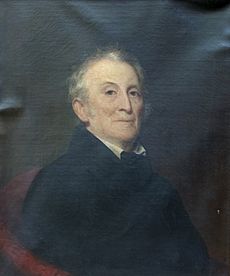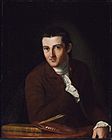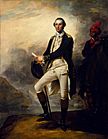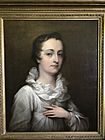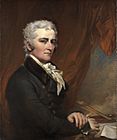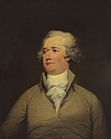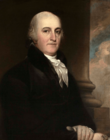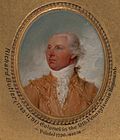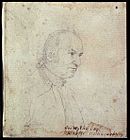John Trumbull facts for kids
Quick facts for kids
John Trumbull
|
|
|---|---|
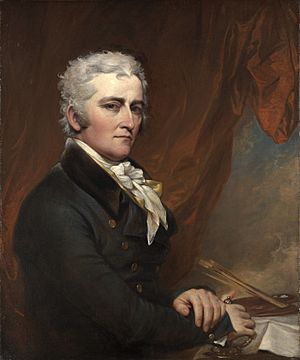
Self-portrait, c. 1802
|
|
| Born | June 6, 1756 |
| Died | November 10, 1843 (aged 87) New York City, New York, U.S.
|
| Nationality | American |
| Education | Harvard College |
| Known for | Painting |
|
Notable work
|
Declaration of Independence (painted 1817–1819) |
John Trumbull (June 6, 1756 – November 10, 1843) was an American artist. He lived during the time when the United States was becoming an independent country. He is famous for his historical paintings that show important moments from the American Revolutionary War. He even fought in the war himself! People often call him the "Painter of the Revolution."
One of his most famous paintings is Declaration of Independence (painted in 1817). This painting is so important that it hangs in the United States Capitol rotunda in Washington, D.C. You can also see it on the back of the current United States two-dollar bill.
Contents
Early Life and Education
John Trumbull was born in Lebanon, Connecticut, in 1756. His father, Jonathan Trumbull, was the governor of Connecticut for many years. John came from a family that had lived in Connecticut since the early days of the American colonies.
He had two older brothers. One brother, Joseph, helped supply the American army during the Revolutionary War. His other brother, Jonathan Trumbull Jr., later became the Speaker of the House for the United States.
When John was 15, he started college at Harvard College. He graduated in 1773. John had an accident as a child and lost the use of one eye. Some people think this might have made him paint with a lot of detail.
Serving in the Revolutionary War
John Trumbull was a soldier in the American Revolutionary War. He helped the army by drawing maps of the British and American battle lines around Boston. He even saw the famous Battle of Bunker Hill.
He became a special helper, called an aide-de-camp, to General George Washington. Later, he worked for General Horatio Gates. In 1777, he left the army after a disagreement about when he was officially made an officer.
In 1780, John needed money, so he decided to become a full-time artist. He traveled to London, England. There, he studied painting with a famous artist named Benjamin West. West suggested that Trumbull paint small pictures of the War of Independence. He also painted many tiny portraits, called miniatures. He painted about 250 of these in his life. During this time, he also painted a portrait of Washington from memory.
In September 1780, a British spy named Major John André was captured in America. He was later hanged. When this news reached Great Britain, people were very angry. John Trumbull was arrested in London. He was accused of being a spy because he was an officer in the American army, just like André. He was held in prison for seven months.
After he was released, Trumbull sailed back to the United States. The trip took six months, and he arrived in January 1782. He then helped his brother supply the army in New York during the winter of 1782–83.
Painting Famous American History
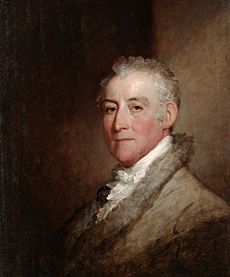
In 1784, after Britain recognized America's independence, Trumbull went back to London to study art again. His first big painting, The Deputation from the Senate Presenting to Cincinnatus the Command of the Roman Armies, was shown at the Royal Academy of Arts. In this painting, Trumbull made the Roman hero Cincinnatus look like George Washington.
While in his studio, Trumbull painted two important war scenes: Battle of Bunker Hill and Death of General Montgomery in the Attack on Quebec. Both of these paintings are now at the Yale University Art Gallery.
In 1786, Trumbull visited Paris, France. There, he drew sketches of French officers for his painting Surrender of Lord Cornwallis. With help from Thomas Jefferson, who was the American ambassador in France, Trumbull started working on his famous Declaration of Independence painting. For the next five years, he painted small portraits of the people who signed the Declaration. He used these portraits to create the larger painting. If someone had already passed away, he would copy an older portrait of them.
While meeting with the signers or their families, Trumbull also tried to sell subscriptions for copies of his paintings. These copies would be made into engravings.
Trumbull's Declaration of Independence painting was bought by the United States Congress. Congress also bought three other paintings by him that showed important moments from the Revolution: Surrender of General Burgoyne, Surrender of Lord Cornwallis, and General George Washington Resigning His Commission. All four of these large paintings now hang in the United States Capitol rotunda.
Trumbull painted several other important scenes from the Revolution:
- Death of General Warren at the Battle of Bunker's Hill
- Death of General Montgomery in the Attack on Quebec
- Capture of the Hessians at Trenton
- George Washington at Trenton, New Jersey, on the night of January 2, 1777 (Trumbull thought this was his best portrait of Washington)
- Death of General Mercer at the Battle of Princeton
- Washington at Verplanck's Point, a gift to Martha Washington in 1790
- George Washington, painted for New York City in 1790
- The Sortie Made by the Garrison of Gibraltar, 1789
Later Years and Legacy
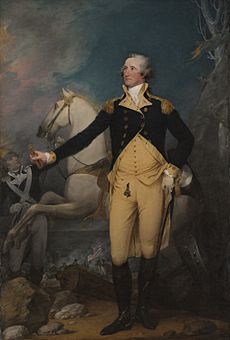
Trumbull also painted many portraits of important people. These include full-length paintings of General Washington (1790) and George Clinton (1791), which are now in New York City Hall. New York City also has his portraits of Alexander Hamilton (1805), whose face is on the $10 bill, and John Jay.
In 1791, Trumbull became a member of the American Academy of Arts and Sciences. In 1792, he joined the American Philosophical Society.
He painted portraits of John Adams (1797), Rufus King (1800), and others. He also painted several self-portraits, including one in 1833.
In 1794, Trumbull worked as a secretary for John Jay in London. Jay was negotiating a treaty with Great Britain. Later, Trumbull was part of a group that settled claims between American and British merchants after the war.
Trumbull had some tough times trying to sell his paintings. In 1831, he sold 28 paintings and 60 miniature portraits to Yale University. In return, Yale gave him $1,000 each year for the rest of his life. This was a way for him to earn money from his art. Yale University now has the largest collection of his works.
Trumbull was the president of the American Academy of the Fine Arts in New York City from 1816 to 1836. He believed in old-fashioned art styles and didn't get along well with the students. His painting skills also started to decline. In 1825, many students left and started their own art school, the National Academy of Design. The American Academy later closed in 1839.
John Trumbull wrote his life story, which was published in 1841. He passed away in New York City on November 10, 1843, at the age of 87.
Honors and Remembering John Trumbull
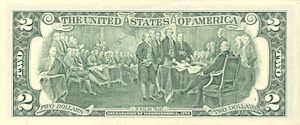
- John Trumbull was first buried with his wife under the Art Gallery at Yale University, which he designed. Later, in 1867, his art collection was moved to a new building called Street Hall. His and his wife's remains were also moved there.
- In 1965, the John Trumbull Birthplace in Lebanon, Connecticut, was named a National Historic Landmark.
- In 1968, a special postage stamp was made to honor John Trumbull.
Paintings by John Trumbull
- The Death of General Warren at the Battle of Bunker's Hill, June 17, 1775
- The Death of General Montgomery in the Attack on Quebec, December 31, 1775
- Declaration of Independence
- The Capture of the Hessians at Trenton, December 26, 1776
- The Death of General Mercer at the Battle of Princeton, January 3, 1777
- The Surrender of General Burgoyne at Saratoga
- The Surrender of Cornwallis at Yorktown
- General George Washington Resigning His Commission
- Portraits of George Washington, John Adams and Alexander Hamilton
- The Death of Aemilius Paullus at the Battle of Cannae
- The Sortie Made by the Garrison of Gibraltar
- Self-portrait
- Portrait of Josiah Bartlett
- Jonathan Trumbull, Jr. (1740–1809) with Mrs. Trumbull (Eunice Backus) (1749–1826) and Faith Trumbull (1769–1846)
Gallery
Historic Events
-
The Declaration of Independence (event 1776, painted 1819)
-
The Capture of the Hessians at Trenton, December 26, 1776 (event 1776, painted 1786–1828)
-
Surrender of General Burgoyne (event 1777, painted 1821)
-
Surrender of Lord Cornwallis (event 1781, painted 1820)
Portraits
-
George Washington, 1780
-
George Clinton, 1791
-
Richard Varick, 1805
Miniature Portraits and Sketches
-
Israel Putnam, 1790
-
George Wythe, 1791
See also
 In Spanish: John Trumbull para niños
In Spanish: John Trumbull para niños


